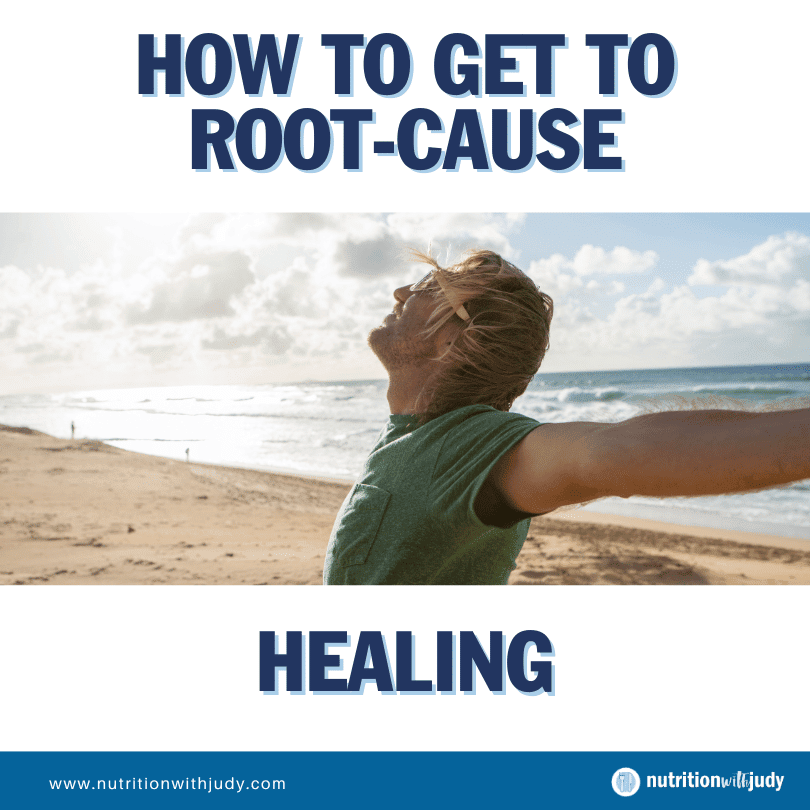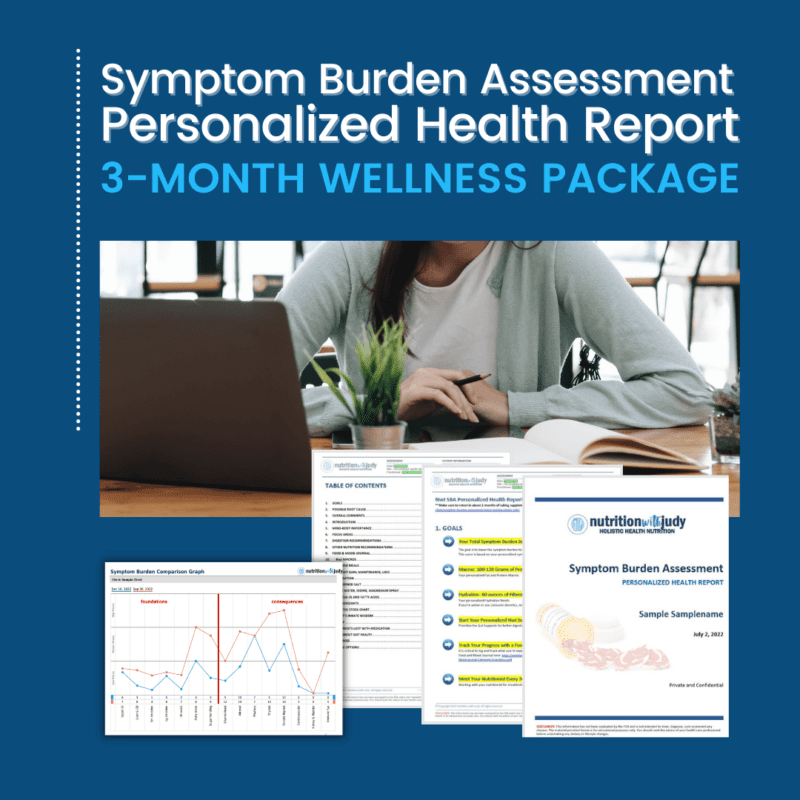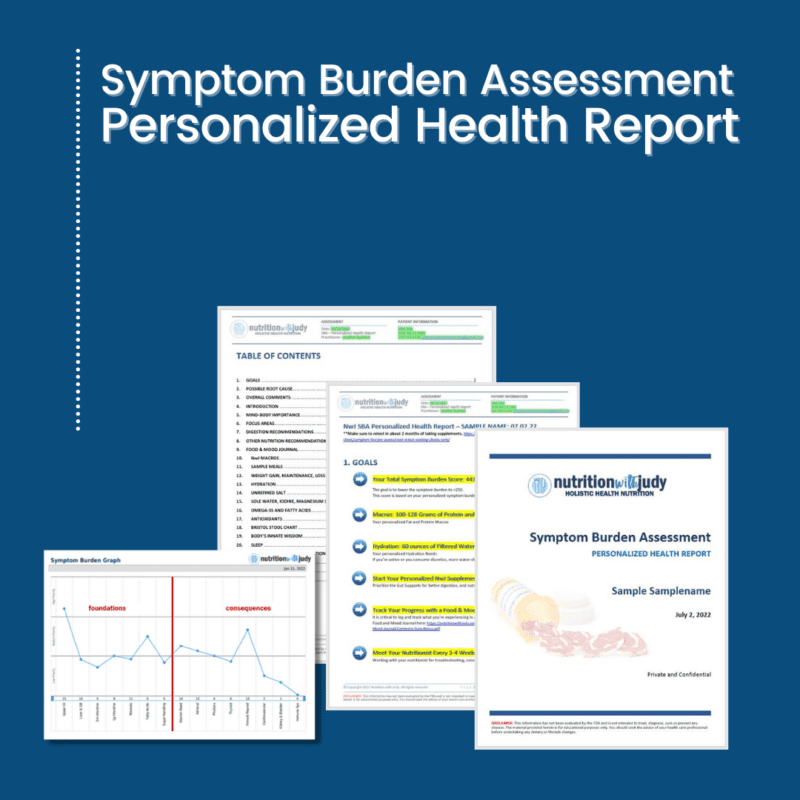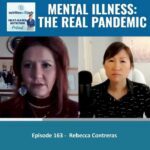

How to Get to Root Cause Healing? Free Yourself of Physical and Mental Symptoms


I often get asked, “I need to heal my gut; I need to find the root cause. But how do I do that?”
My answer usually is, it depends. It depends on your symptoms and where you’re starting from in your healing journey.
One way we get to the root cause healing is through the Symptom Burden Assessment (SBA).
The Symptom Burden Assessment is the first step to working with the Nutrition with Judy team as a one-on-one client.
The Symptom Burden Assessment
What is the symptom burden assessment?
The SBA is a self-guided questionnaire that provides a symptom burden graph and a Severity and Symptom Burden Report.
The symptom burden is something to consider if your diet is not working perfectly for you. It will help you figure out root-cause based on the symptoms you are experiencing. No one knows your physical and mental symptoms better than you. The power of the symptom burden is identifying these symptoms.


Above you will find the symptom burden (SBA) graph.
Everything to the left of the red line is what we consider the foundations or root cause. This includes the
- Upper GI,
- Liver/Gallbladder
- Small intestine
- Large intestine
- Minerals
- Fatty acids
- Sugar handling
We want to focus first on healing these areas.
Please note that the upper GI, liver, gallbladder, small intestine, and large intestine are all part of our gut health. This is why I prioritize gut health, and understanding this will be important as we go through the SBA results.
If any of the foundations are imbalanced, there will eventually be adverse consequences. These consequences are to the right of the red line on the graph. These include:
- Vitamin needs
- Adrenals
- Pituitary
- Thyroid
- Male reproduction
- Female reproduction
- Cardiovascular
- Kidney
- Immune system


An imbalance is anything in the High to Medium Priority range.
The above graph indicates a need and support for the Small Intestine. The priority shows high or medium to high.
This could mean some immune imbalances because most of your immune health is in your small intestine. The small intestine is also where nutrients are absorbed, which means we could see a lack of mineral absorption resulting in a greater need for nutrients.
Although the graph does not reflect a strong need for vitamins (“Vitamin Needs”), it is clear that the immune system needs support.
Probiotics may be needed to help rebalance the population in the small intestine and nutrients to help seal the small intestine. The overarching point of this graphic shows an overarching view of the current burden on the body, felt by the person.
People ask me, “What should I take for my gut?” Without taking this assessment, I’m not sure what part of the gut needs support.
GI, upper GI, or GI hypochlorhydria will be different from someone with small intestinal needs.
It may be that the upper GI needs some hydrochloric acid.
The person may need some digestive enzymes. Depending on the body’s ability to break down fat, the liver and gallbladder may also need on a different supplement.
If you struggle with immune health, allergies and even histamines, you may need the probiotic restart kit. If you have SIBO or leaky gut or have been on multiple rounds of antibiotics, this probiotic kit with a meat-only diet will be extremely beneficial for you.
If you don’t have these issues, a quality gut healing kit or a safe detox protocol may be sufficient.
Many clients come to me for thyroid, pituitary, or female reproductive issues, but I don’t prioritize those first. If you look at the symptom burden graph, those issues are usually related to one of the root-cause imbalances.
There usually is something else in the foundation’s section that shows the client needs support. Looking at the graph, the most prevalent deficiency is fatty acids. What questions were answered to produce this result?
Let’s take a look.
While tension headaches at the base of my client’s skull may be fatty acid-related, they could also be adrenals or mineral-health-related. With my review of the symptom burden’s information, I can parse through the different symptoms and see the client’s symptoms, history, lifestyle, and medical information to see what may be causing the headaches.
This is where root-cause healing is so important.
Lack of fatty acids can also cause dry skin and dandruff. Lack of fat from your body or your foods will start pulling the fat from your skin. It can also be related to candida and muscle fatigue.
The graph shows a need for fatty acids. But why is there a need for fatty acids? Does this client eat enough animal fats? Does this client eat fatty fish?
Omega-3s, the fatty acids from fish, especially DHA and EPA, are essential fats. I noticed a lot of clients are fatty acid deficient, including carnivores. I recommend high-quality omega-3s or consuming three servings of fatty fish a week.
Sometimes our body doesn’t stimulate enough bile to help the fatty acids break down and remove toxins. Eating more high-quality fat can also support this process. (You may see this as liver/gallbladder support).
Symptom Burden Conditions


Above are the conditions that the client is currently experiencing based on the results from the symptom burden graph. I like to look at the top five based on score, along with the top five based on percentage.
CONDITIONS — Top 5 based on score


While hyperglycemia is very low on the list, its percentage indicates a probable case of hyperglycemia or blood sugar dysregulation. From the notes in the symptom burden, I know this client has diabetes.
Likely, her body is still trying to balance blood sugars with a meat-based diet. Her energy is probably fluctuating in the evenings and at night, likely waking up to hypoglycemic events, where her blood sugar drops too low, and she’s awakened with a cortisol output response.
Also indicated in the table is GI Hypochlorhydria (deficiency in hydrochloric acid).
On the symptom burden graph, the upper GI shows medium priority. Assuming this client is getting omega-3s from meat, she’s likely not breaking down enough of nutrients in the stomach or absorbing them in the small intestine.
Even if this client consumed significant fish and fatty meats, they would still struggle with nutrient absorption. This person is likely not breaking down most of their food and properly utilizing the nutrients.
Since the small intestine is imbalanced, most nutrients are not absorbed, leading to fatty acid deficiency. If this person is also not eating fish, it makes sense why they are fatty acid deficient. The consumption of fish would be indicated on the symptom burden questionnaire.
Another condition related to the small intestine is immune allergy. 80% of your immune system is in your small intestine, and most of the mast cells are in your small intestine. While removing histamine foods would help, it does not get to root-cause healing. The better solution would be to fix the gut where most of your immune health resides.
Potential Nutritional Deficiencies
Based on the discussed conditions, below are the potential nutritional deficiencies. Simplistically, the consequences are causing the deficiencies in this picture.


The first one is essential fatty acids; that’s not a surprise.
I would recommend consuming fatty fish and taking a quality omega-3 supplement for a few months for this particular client. After a few months, they can also take an omega-3/omega-6 fatty acid test to get a pulse on their fatty acid profile.
The symptom burden should be retaken after a few months to see any changes. They should notice physical and mental changes, but the symptom burden helps identify the root cause. If the priorities are lower, the person would taper down on the supplements, and the symptom burden would be a great indicator of how.
The second deficiency, mineral alkaline ash, is related to electrolytes. While we know this person previously had diabetes, the question is, “Does this person also have high blood pressure imbalances?”
This is a conversation I would need to have with the client.
Vitamin B is B1 (thiamine) and vitamin G is B2 (riboflavin). There’s also B12 and B6. These deficiencies might be from the lack of hydrochloric acid if this person is eating adequate protein. Even if she’s eating meat with substantial sources of B vitamins, a deficiency is still showing.
You need thiamine (vitamin B1) for so many different metabolic functions, including mineral balancing. This is why I think a more well-balanced carnivore diet is beneficial. I wrote this in my don’t eat just beef blog post, as pork has the most thiamine.
If you eat 16–20 ounces of beef daily, you may only get 30% of your thiamine needs for the day. Whereas if you eat nine ounces of pork belly, you will have your total amount of thiamine in a day.
With the symptom burden graph, the symptom burden, the deficiencies and consequences, we can start focusing on a root-cause healing protocol.
My Personal Healing Journey
Below you’ll find my personal SBA results. Healing may not always be linear, but it is always possible. You can see my healing journey in a very candid blog post.


As you can see from the symptom burden graph, I struggled with sugar handling, and my upper GI needed support.
I was deficient in hydrochloric acid. I struggled with disordered eating behaviors, and processed food choices likely caused hydrochloric acid imbalances.
I also have been on antibiotics and had taken laxatives that likely messed with my gut, affecting the large intestine.
What’s helpful about this assessment is that you can track your progression and results. While you are healing, it can be easy to forget some of the healing, especially when you’re still hurting. This symptom burden records a period of time, and it’s a great motivating tool when you retake the test.
Any amount of healing is still progress. We have been on this journey for 100 years. The journey is moving forward day by day.
The power of this symptom burden assessment is that you and only you are taking the same test, answering the way you feel at that very moment. You won’t remember how you answered 400 questions because you answered based on how you felt at that very moment.
When I was keto, I was still struggling with blood sugar imbalance. Imbalanced sugar handling will impact your cortisol, adversely affecting your adrenals. There’s no surprise that my adrenals were a high priority and needed support.
As I worked on my macros, I started taking digestive supplements and my gut healing kit. My favorite was Intestinal Permeability Support (IPS) which focused on strengthening the small intestine. We did lingual neuro testing on our bodies during nutritional training, and my body reacted very well to IPS. Not everyone can take IPS who has small intestinal imbalances. IPS contains shellfish, and many people are sensitive to shellfish.
For me, IPS was a game-changer.
In March of 2020, my upper GI and liver needs were in the low priority, which is what we want everyone to achieve. If I only took the test once, I wouldn’t know if there was any positive or negative progression. It’s clear that there’s been healing.
This was the result of my:
- following a gut-healing supplement protocol
- meat-only diet
- removing processed dairy
- choosing fattier cuts of meat (and adding more fat)
- adding more salmon
In 2020, nothing was showing up as a priority for my thyroid. I took no thyroid medication. As I worked on balancing the root cause areas, my gut health, minerals, fatty acid, and sugar handling, all other focus areas have consequentially reduced in priority.
This is what I define as root cause healing.
Since working on my gut, I no longer take a lot of these supplements. Sometimes I will take a high-quality omega-3 supplement because I don’t eat enough fish.
I can tell the difference with my skin (it gets dry without enough fatty fish). My muscles tend to feel weak when climbing stairs. This is why I recommend eating at least three servings of fatty fish a week. I shared more about this in a YouTube video.
In Closing
Taking the time to heal will allow you to better listen to your body. We may not always live a perfectly balanced life, but knowledge is power. I encourage everyone who wants to heal, to start with the symptom burden assessment.
You no longer have to guess which supplement or nutrient your body needs.
The Symptom Burden Assessment is the first step to working with the Nutrition with Judy team. Without the symptom burden, we don’t have adequate information about the client to start the one-on-one sessions.
In addition to the symptom burden results, you will be provided:
- Detailed notes address some of your top priorities and concerns (what you physically feel, as well as what the symptom burden shares)
- Custom supplement protocol for your specific needs (especially gut- and targeted nutrient supports)
- Custom meat-based diet macros for your personal needs
- Custom hydration support for your needs
- Nutrition with Judy digestion tips
- Carnivore Cure elimination and reintroduction tips
- Sleep support recommendations
- Lifestyle suggestions
- Testing options
If you are tired of being unwell, the symptom burden allows you to finally start figuring out what is going on and how to best support yourself to get to root-cause healing.
The SBA can be taken now and again in four to six months. This will track your results and help identify what supplements or dietary changes you need to make with the new results.
With ♥ and hope for healing,


Work With Our Trusted Carnivore Diet Functional Nutritional Therapy Practitioners
The Nutrition with Judy practice is honored to be a trusted carnivore diet practitioner support serving clients from around the globe. We’re passionate about helping our clients achieve root-cause healing in order to lead the best quality of life possible that’s nearly symptom-free. Our team is dedicated to utilizing the most effective tools to find your root cause. We welcome you to explore our free resources and are always available to support you through personalized protocols. Our Symptom Burden Assessment (SBA) is the perfect starting point for discovering your root cause and is required to work with our team— you can learn more in-depth about this powerful tool here.
Start your root-cause healing journey today and contact us any time with any questions or concerns.
DISCLAIMER: This content is for educational purposes only. While we are board-certified in holistic nutrition and are nutritional therapy practitioners, we are not providing medical advice. Whenever you start a new diet or protocol, always consult with your trusted practitioner first.







Jo Ann Atilano
January 7, 2024 at 11:51 amDearest Judy, thank you so much for taking the time to explain this complex topic to me – I really appreciate how you broke it down in a way that’s easy to understand, and I feel more confident about tackling it now.